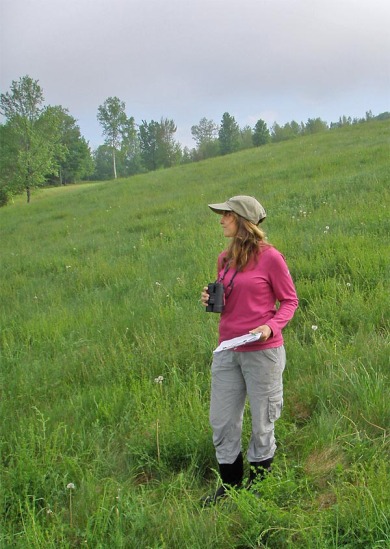Birders across New England are invited to greet the sunrise and enjoy the tumbling song of the bobolink on clear mornings this Spring and Summer in open fields, conducting bird surveys for the Vermont Center for Ecostudies (VCE) and Massachusetts Audubon.
The project is a re-survey of grassland bird habitat across New England, 15 years after an initial study led by Mass Audubon and partners. With the help of citizen scientists, we will revisit the hundreds of sites across New England surveyed during 1997-2000, using similar methods.
The surveys will reveal just how severely grassland bird populations have declined in the Northeast. Losses in the region are part of a larger trend across the continent for species such as Bobolink and Eastern meadowlark that largely depend on agricultural lands. Habitat loss due to development, intensification of agricultural practices, and succession of grasslands to forest are the main causes for the declines.
Natural grasslands existed historically in the Northeast, but did not become a dominant habitat type until agricultural expansion in the 18th and 19th centuries. In the past 75 years, the region’s forest have recovered, reducing the available nesting habitat for grassland species. Conservation of these species in the Northeast now hinges on a greatly reduced area, and requires a focus on enhancing habitat quality on agricultural lands as well as those managed for an “open” aesthetic. The comes as grassland birds continue to decline in the core of their ranges (the Midwestern US), rendering efforts to maintain remaining habitat in the Northeast more critical than ever.
New England remains an important area for dairy farming, which accounts for a large percentage of grassland bird habitat. But changes in farming practices over the last 30 years mean that even hay fields can spell peril for nesting birds. Earlier and more frequent mowing and a more closely cropped crop can leave little room for grassland breeding birds to complete their nesting cycles.
Landowners are often receptive to learning how small adjustments in their management activities can mean big gains for grassland bird nesting success. Landowner outreach will be an important component complementing the bird surveys in this regional project. VCE’s “Upper Valley Grassland Bird Conservation Project” with Plymouth State University graduate student Jamie Sydoriak is spearheading such outreach in Vermont and New Hampshire’s Connecticut River Valley (read about it here). By following field research with outreach and education, we can better ensure that viable populations of grassland birds persist within a rapidly changing landscape.
Birders who would like to volunteer for this project should be able to:
- Identify grassland birds and those of neighboring and related habitats (edge species, scrub-shrub species, etc.), by sight and sound
- Be willing and able to visit designated sites during fair weather between May 1 and July 15, between dawn and 10 am.
- Be able to conduct 10-minute point counts following the study protocol, identifying and logging all bird songs heard within a 10-minute interval.
- Keep careful data records and submit them electronically to the project coordinator.
Liz Newlands at Massachusetts Audubon will serve as Project Coordinator; volunteers interested in surveying sites in any New England state should contact Liz at lnewlands”at”massaudubon.org.

